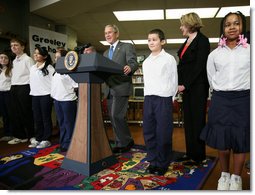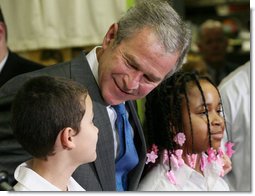
- Afghanistan
- Africa
- Budget Management
- Defense
- Economy
- Education
- Energy
- Environment
- Global Diplomacy
- Health Care
- Homeland Security
- Immigration
- International Trade
- Iraq
- Judicial Nominations
- Middle East
- National Security
- Veterans
|
Home >
News & Policies >
January 2008
|
For Immediate Release
Office of the Press Secretary
January 7, 2008
President Bush Discusses the No Child Left Behind Act
Horace Greeley Elementary School
Chicago, Illinois
![]() Fact Sheet: Six Years of Student Achievement Under No Child Left Behind
Fact Sheet: Six Years of Student Achievement Under No Child Left Behind
10:46 A.M. CST
THE PRESIDENT: Thank you all. Please be seated. Thank you very much for coming. I am so honored to be at Horace Greeley. People say, why would you want to come to Horace Greeley? Because it's a center of excellence. It's a place for this country to realize what is possible when you have a good principal, that's supported by the community, when you've got teachers who work hard and students willing to learn.
 Coming with me today is the Secretary of Education, Margaret Spellings.
Madam Secretary, I'm honored you're here. She's -- she and I share the
same philosophy. It starts with our refusal to accept school systems that
do not teach every child how to read and write and add and subtract, and
our firm belief that local folks can figure out the best way to chart a
path to excellence.
Coming with me today is the Secretary of Education, Margaret Spellings.
Madam Secretary, I'm honored you're here. She's -- she and I share the
same philosophy. It starts with our refusal to accept school systems that
do not teach every child how to read and write and add and subtract, and
our firm belief that local folks can figure out the best way to chart a
path to excellence.
I'm proud that Congressman Rahm Emanuel is here. Mr. Congressman, thank you. As you know, we're from different political parties. (Laughter.) But we share a common concern, and that is doing what's right for America. Both of us understand that educational excellence is not a partisan issue; it is an issue that is important for the future of this country. So, Congressman, I'm proud you're here.
I'm also proud to be here with His Honor, Mayor Daley. I've come to know the Mayor over seven years of being your President. The first thing I learned about him, it's better to have him for you than against you when you run for office. (Laughter.) He loves his city, and he's, in my judgment, one of our nation's best mayors. He also has taken advantage of a reform that gave mayors the capability of setting the tone and the pace for education in our big cities. Some of the best reforms in America have taken place when the mayor has taken the lead and, Mr. Mayor, you have certainly taken the lead.
And I'm proud of your passion. I can remember visiting with you earlier on about education, before No Child Left Behind came into being, and the Mayor had this strong sense and strong feeling that this country needed to do something differently if we wanted to make sure every child got a good education.
I'm proud to be here with Rufus Williams. He's a Chicago Board of Education man. I appreciate you being here, Rufus. And I also want to thank Arne Duncan. These two men are very much involved in making sure that if something is working, it is enhanced; and if something is not working, it is changed for the sake of our children. Every good school-- every school that succeeds -- by the way, it's a Blue Ribbon School. So I asked Margaret -- like, I remember coming up, everybody was a blue ribbon school. I don't know if you remember those days. It was kind of a feel-good era. Just say, okay, you're a blue ribbon school, and everybody feels better about education.
 There's less than 300 Blue Ribbon schools across America this year. I
think -- what did you say, thirteen --
There's less than 300 Blue Ribbon schools across America this year. I
think -- what did you say, thirteen --
SECRETARY SPELLINGS: Two hundred and thirty nine public.
THE PRESIDENT: Two hundred thirty nine public schools are Blue Ribbon Schools, and maybe a dozen here in the state of Illinois. This is one of the Blue Ribbon Schools. It's a Blue Ribbon School because it's excelling. It's meeting standards. And one of the reasons is, it's got a fine principal in Carlos. I'm proud to be with you, Carlos. Carlos understands that we have got to set high standards for our children and work with the teachers to achieve those standards.
I was honored to go to some of the classes. It was -- it's exciting to go back to the classroom. One of my messages is to the teachers: America can't thank you enough for teaching. It's truly important to -- for our teachers to be thanked. It's also important for parents to be involved, and for those of you who are parents, thank you for being here today.
Tomorrow is the 6th anniversary of the day that I signed the No Child Left Behind Act into law. And since that day we've come a long way, fewer students are falling behind. People are beginning to get used to the notion that there's accountability in the public school system. Look, I recognize some people don't like accountability. In other words, accountability says if you're failing, we're going to expose that and expect you to change. Accountability also says that when you're succeeding you'll get plenty of praise.
I think it's -- I know No Child Left Behind has worked. And I believe this country needs to build upon the successes. The philosophy behind No Child Left Behind was in return for money there ought to be results. It's pretty commonsensical it seems like to me. That's what the Mayor asks when he is running his city. That's what corporations ask -- if we're going to spend money, are we going to get a return on the money? That's what our schools ought to be asking, too.
In other words, in return -- and I -- you know, I was -- I was an old governor of a state. I didn't particularly like it when the federal government got involved with my business. I felt Texas could pretty well handle it on her own. On the other hand, I recognize that if we're spending federal money, that we ought to be held to account for that money. And there's some federal money involved in education, and it makes sense for those of us in Washington to say, sure, we'll spend it, but we want to make sure that that money is being spent for a good reason. And there's no better reason than to teach every single child how to read, write and add and subtract.
 And so we have set standards; expectations. And by the way, I believe if
you have low expectations, you're going to get lousy results. As a matter
of fact, I know that's what's going to happen. But if you have high
expectations, it's amazing what can happen.
And so we have set standards; expectations. And by the way, I believe if
you have low expectations, you're going to get lousy results. As a matter
of fact, I know that's what's going to happen. But if you have high
expectations, it's amazing what can happen.
This school, Horace Greeley, set high expectations. It's easy to set low expectations, you know. It's easy to consign a whole group of students to mediocrity. That's the easy way out. What No Child Left Behind says is that we're going to take the hard way. We're going to set high standards, and then we're going to measure to determine whether or not those standards are being met. It's really important to measure. It's also important to disaggregate results, which is like a fancy word for we want to know whether or not each student is learning. We want to make sure that no child is left behind.
Horace Greeley measures, and they measure for a reason. They want to know, first of all, whether or not the curriculum is working, whether or not the instruction is working. And they also want to know whether or not they can -- they need to tailor specific programs to meet the needs of specific children. One reason this school is a Blue Ribbon School, it is not afraid of accountability. It views the accountability system as a tool to enhance excellence. And so do I.
Now the other thing that's important is, is that the accountability system allows each school to know where it stands relative to another school. You know, from my time as governor, I can remember parents saying, oh, my school is doing just fine; I like my school, Governor. And then all of a sudden, the test scores came out -- sometimes a school wasn't doing just fine. Sometimes -- not "sometimes," all the time, accountability lays out the truth. There's nothing better, in my judgment, to making sure that we have a educated workforce, and everybody has a hopeful future, than to just lay out some simple truths.
And one of the simple truths is, can this child read at grade level at the appropriate time. That's a simple truth. Another one is, can the person add and subtract at the appropriate time, and if so, we'll say thank you. And if not, the system ought to say, we better change early, before it's too late.
I found too often that in some schools, like in my state, it was just easy to move them through, you know; let's just shuffle people through. That's why -- I can remember somebody standing up and saying, No Child Left Behind Act is really one of the civil rights -- it's a civil rights piece of legislation, because this person was sick and tired of the day when people were just moved through the school system, without wondering whether or not the child could read and write and add and subtract.
Test results are all a part of making sure we achieve a great national goal, and that is, every child be at grade level by 2014. The other thing it does is, as you measure, it lets us know how we're doing as a nation. There's an achievement gap in America that's just not acceptable. That means Anglo students are more proficient at reading than Latinos or African Americans; it's just not acceptable for our country. It's an indication to me that there is something wrong, and it needs to be addressed now.
And so -- but we measure for that reason. We want to know whether or not this nation is going to be competitive, and whether or not it's going to be hopeful. And the achievement gap said, here's a problem. But the good news is, is that because of high standards and accountability throughout this country, the achievement gap is closing. We have what's called a National Report Card. One of Margaret's jobs is to herald the successes or failures of the National Report Card. Eighth graders set a record high for math scores last year. Our 4th graders are -- more and more 4th graders are learning to read at grade level. Scores for minority and poorer students are reaching all-time highs in a number of areas, and the achievement gap is closing. If we didn't measure we wouldn't know, we'd be just guessing, and it's not worthwhile to guess when a child's future is at stake.
The other thing that's interesting about measurement is that when you find a problem there will be resources like after-school tutoring to help a child address those problems. And it's important to do this early, rather than late. People who have been involved in education can tell you that a school system that doesn't test and doesn't measure oftentimes wakes up at the end of the process and says, we need remedial education as the child heads into high school, or out of high school. That's just not acceptable anymore. The world is too competitive to have a lax system in place. And we don't now, with No Child Left Behind.
And so now is the time for Congress to reauthorize it. I'm sure a lot of people look around the country and say it's impossible for Congress and the President to work together. I strongly disagree. We worked together to get the bill written in the first place, and I believe we can work together to get it reauthorized. If it's not reauthorized, then I've instructed our Secretary to move forward on some reforms or to analyze reforms that she can do through the administrative process. If Congress passes a bill that weakens the accountability system in the No Child Left Behind Act, I will strongly oppose it and veto it, because the act will continue on -- in other words, this act isn't expiring, it just needs to be reauthorized.
And what are some of the things we can do? Margaret has been listening to members of Congress, but equally importantly, she's been listening to governors and local school boards. We need to increase the flexibility for our states and districts. We don't want the No Child Left Behind Act to be viewed as something that hamstrings innovation. There ought to be flexibility in the system. We're going to provide help for struggling schools -- extra help. We want to make sure that a high school degree means something. We don't want people getting out of high school and it's not meaning something.
She's been talking with members of Congress to give schools credit for growth and achievement that individual students make from year to year -- in other words, flexibility in the accountability system without undermining the core principle of accountability. We're going to implement a more accurate system for measuring high school drop-out rate, and make it easier for our students to enroll in the tutoring programs. There are things we can do, and must do, by working together.
I am optimistic about the country because I come to places like Horace Greeley Elementary School: a little center of excellence; a place where, you know, some might say, well, these kids can't possibly achieve such high standards. But, in fact, they are. This is a school that's got a significant number of Latinos who families may not speak English as a first language. This is a school where there's some newly arrived to our country here. This is a school that is exceeding expectations because of high standards and using the accountability system as a tool to make sure that no child is left behind.
It is my honor to be with you. Thank you for letting me come and share our philosophy about how to achieve educational excellence for every student. God bless. (Applause.)
END 11:01 A.M. CST


